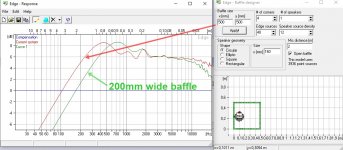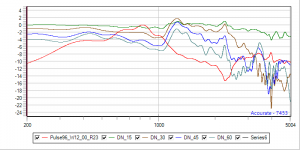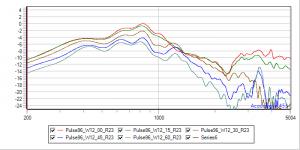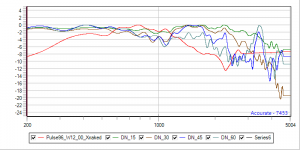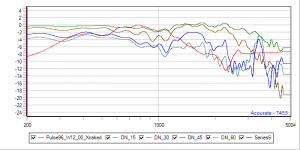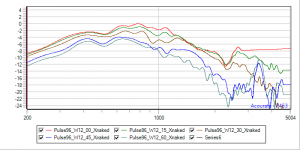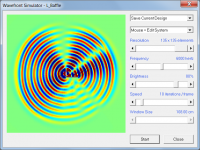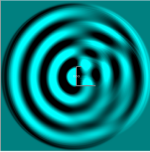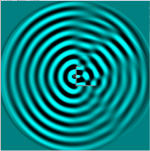They were briefly mentioned.. but if we're to say they are an important part of the design, they should stay where they are vs frequency.
Yes, for true dipole behaviour. In the videos IIRC he mentions only OB, a subtle difference 😉. In a room and for simplicity of design, which I think is what he's after since he mentions the complexity of SL's ultimate design re EQ and amps (in earlier part), would the cons outweigh the pros?
Last edited:
Was that a rhetorical question, or are you asking the difference between an open baffle and a dipole?
Neither. I think OB is used rather loosely at times, ie, it's not always a dipole and often very far away.
Good discussion and I second Daihedz totally!
Open baffle "cult" is open to any kind of "efforts", which typically would have very strange off-axis/3D radiation patterns, specially the 2-way ones.
With some eq or just good luck one might get decent in-room response and that magical OB sound. Anyway smooth on-axis (+/-15deg) is the most important thing. Haphazard off-axis and rearside radiation will always be influenced by room placement-related interefrences, and sometimes a decent result can be achieved.
Baffle dimensions and driver diameter are the most important factors. Baffle shape and driver placement in it will modify the response above dipole peak, and this is why 4-way construction with narrowing baffle will give best results regarding dipole pattern.
I haven't learnt VituixCAD, but The Edge has helped me enormously to get grasp of these things. Unfortunately sidewings can't be simulated by either.
p.s. i don't give Audiocircle gurus Ritchie or matevana any respect regarding OB design, and I have practically stopped following. When I visit I get nausea very fast...
Open baffle "cult" is open to any kind of "efforts", which typically would have very strange off-axis/3D radiation patterns, specially the 2-way ones.
With some eq or just good luck one might get decent in-room response and that magical OB sound. Anyway smooth on-axis (+/-15deg) is the most important thing. Haphazard off-axis and rearside radiation will always be influenced by room placement-related interefrences, and sometimes a decent result can be achieved.
Baffle dimensions and driver diameter are the most important factors. Baffle shape and driver placement in it will modify the response above dipole peak, and this is why 4-way construction with narrowing baffle will give best results regarding dipole pattern.
I haven't learnt VituixCAD, but The Edge has helped me enormously to get grasp of these things. Unfortunately sidewings can't be simulated by either.
p.s. i don't give Audiocircle gurus Ritchie or matevana any respect regarding OB design, and I have practically stopped following. When I visit I get nausea very fast...
Last edited:
Looking again at Allen's sims, they don't seem as bad as I initially thought, I'd got them reversed front to back in my mind 🙂 Let's see if Danny responds, is it too painful for you to go there Juha? 😉
^Sorry I'm too weak for that!
Years ago and for years I asked matevana for measurements without success, he hardly even responded at all. Danny might be easier, but please save me. I don't have much free time now but basically I could do a quick proto and measure it myself. I have only 4" drivers at hand now.
Years ago and for years I asked matevana for measurements without success, he hardly even responded at all. Danny might be easier, but please save me. I don't have much free time now but basically I could do a quick proto and measure it myself. I have only 4" drivers at hand now.
I have no data about adding fins to a baffle. But I have modest data adding a ring at the back of a naked midrange driver, dating from some time ago. Driver was a Seas Excel W12CY001. The ring was 23mm in dept.
I assessed the polar behavior in increments of 15° from 0° to 60°.
0° red
15° green
30° brown
45° blue
60° grey
The three graphs of each setup show
A. The curves 0° to 60° such as after normalizing the max. of the 0°-measurement to 0dB
B. The the differences between 0° and the angled 15° to 60° measurements
C. Is B, but all curves normalized/nulled to max = 0dB
Naked:
_Amplitude_Naked.png
_Amplitude_Naked_Diff.png
_Amplitude_Naked_Diff_Nulled.png
Backring version:
_Amplitude_Ring23.png
_Amplitude_Ring23_Diff.png
_Amplitude_Ring23_Diff_Nulled.png
Watch the behavior of the polar in the useful range of this midrange, e.g. between 700Hz and 2.5kHz. Both versions do have an annoying anomaly between 1kHz ... 1.2kHz. The ringed version was mixed blessings, whith a tendency of worsening the polar behavior.
I assessed the polar behavior in increments of 15° from 0° to 60°.
0° red
15° green
30° brown
45° blue
60° grey
The three graphs of each setup show
A. The curves 0° to 60° such as after normalizing the max. of the 0°-measurement to 0dB
B. The the differences between 0° and the angled 15° to 60° measurements
C. Is B, but all curves normalized/nulled to max = 0dB
Naked:
_Amplitude_Naked.png
_Amplitude_Naked_Diff.png
_Amplitude_Naked_Diff_Nulled.png
Backring version:
_Amplitude_Ring23.png
_Amplitude_Ring23_Diff.png
_Amplitude_Ring23_Diff_Nulled.png
Watch the behavior of the polar in the useful range of this midrange, e.g. between 700Hz and 2.5kHz. Both versions do have an annoying anomaly between 1kHz ... 1.2kHz. The ringed version was mixed blessings, whith a tendency of worsening the polar behavior.
Attachments
Last edited:
Thanks for your post and I concur. Regards the above, at a single listening position in a small room, listening near field, might the downsides be less of an issue? Danny's concern seems mainly with the width of the baffle and if the (large) wing was on the inside edge there would still be a partial null towards the sidewalls. Although, looking at Allen's sims there are null/dips more on axis too.
The example of a small room, at a single listening position, listening near field, is exactly my situation. But I'm still not clear on what would be the best approach.
Wide vs narrow baffle?
No wings, short (4") symmetrical wings, or asymmetrical wings with one about 12" to 14"?
I wish I had the means to do that. Only if you want, it would be interesting though, unless we can presume Allen's sims give a pretty good idea?I don't have much free time now but basically I could do a quick proto and measure it myself. I have only 4" drivers at hand now.
@classicalfan. Are you familiar with Linkwitz Lab, particularly the section linked to earlier? The less baffle the better, wings are a way to widen it but can case cavity resonances, having one wing means no cavity. OB and dipoles are all about compromises, perhaps the LX521 could be called "no compromise"
I would call the LX521 a proficient, a sophisticated compromise. And a successful compromise also. Successful in many terms. But still a compromise. Strictly speaking. Because it is not possible not to compromise in speaker building ... as you mention, specifically here in terms of OB and dipoles.... the LX521 could be called "no compromise"
Last edited:
...
p.s. i don't give Audiocircle gurus Ritchie or matevana any respect regarding OB design, and I have practically stopped following. When I visit I get nausea very fast...
Audiocircle is a commercial enterprise paid for by manufacturers who can create their own ‘circle’ and say just about anything they want. Virtually everything posted there regarding audio products has a subjective basis to it.
That’s compared to this forum which is composed primarily of people with little or no commercial interest. It's pretty clear which one can be trusted to be more objective.
Last edited:
@classicalfan. Are you familiar with Linkwitz Lab, particularly the section linked to earlier? The less baffle the better, wings are a way to widen it but can case cavity resonances, having one wing means no cavity. OB and dipoles are all about compromises, perhaps the LX521 could be called "no compromise"
Yes, I've look at it. And it's way beyond anything I have a desire to build. I'm trying to keep things simple.
Small carpeted room only 11 feet wide, close listening position, seating just for me. And yet I'm looking for a big, wide sound stage, since mostly what I listen to is classical symphonies and some opera. Don't need the bass to go extremely low. More interested in the midrange being clear and true.
So I think that leads me to narrow baffle rather than wide. But still not certain whether wings would be a good thing or not. I'm thinking of making a test baffle where I can easily change the wings and see the difference they make.
I'd long been interested in fullrange drivers and open baffle but after a lot of research decided the two together was too much of a compromise, most (all?) of these kind of speakers used a very large baffle which cause too many problems.I'm trying to keep things simple.
I chose to build the Jordan VTL http://www.ejjordan.co.uk/PDFs/Eikona_2_VTL.pdf but made the rear panel removable so I could see how well it might work as an OB. It effectively has 3 inch wings. Obviously it had no bass, so I built U-frame (sub)woofers to deal with that. It worked quite well but still needed EQ, it's a high excursion driver which helps but I'd rather an acoustic solution to mitigate IMD.
If you listen nearfield you've already largely removed the room from the equation so true dipole behaviour shouldn't be such a necessity but OB has other qualities which can still be enjoyed. This is why I'm interested in this solution.
If anything, I wish the simulator showed a contrast scale. Still, David McBean adapted it for simple prototyping in Hornresp.exe (IIRC).unless we can presume Allen's sims give a pretty good idea?
If there are any other shapes you want to see, just call them out.
The smaller room is where the room involvement is more critical. Waveguide theory tends toward the importance of larger, perhaps more narrow, ie more control in such rooms.Small carpeted room
The dipole isn't often mentioned without talking about the nulls, but really it's a fairly wide radiator. A back of an envelope calculation suggests 10dB less DI than a 90 degree waveguide for a 1/4wl dipole. Quite some room involvement.
Is that reason to maybe go the other way and introduce a good diversity of early reflections rather than leaving them thin and discrete?
David McBean adapted it for simple prototyping in Hornresp.exe
Attachments
Thanks very much Allen and David. What would a baffle 12" wide with one 3" wing and one 12" (and 15" for comparison) look like please?
There would also be a 3" "wing" on top the same distance from the driver as the sides, I don't know what difference that would make or if it can be simulated.
The distances are relative. Even though hornresp does coordinate it's designs with frequencies. I've been doing freestyle baffles.
Therefore I'm just trying to get some relevant frequencies to go with them.
First 12/12/3
Therefore I'm just trying to get some relevant frequencies to go with them.
First 12/12/3
Attachments
- Home
- Loudspeakers
- Multi-Way
- What is the polar response of "L-frame" OB speakers
